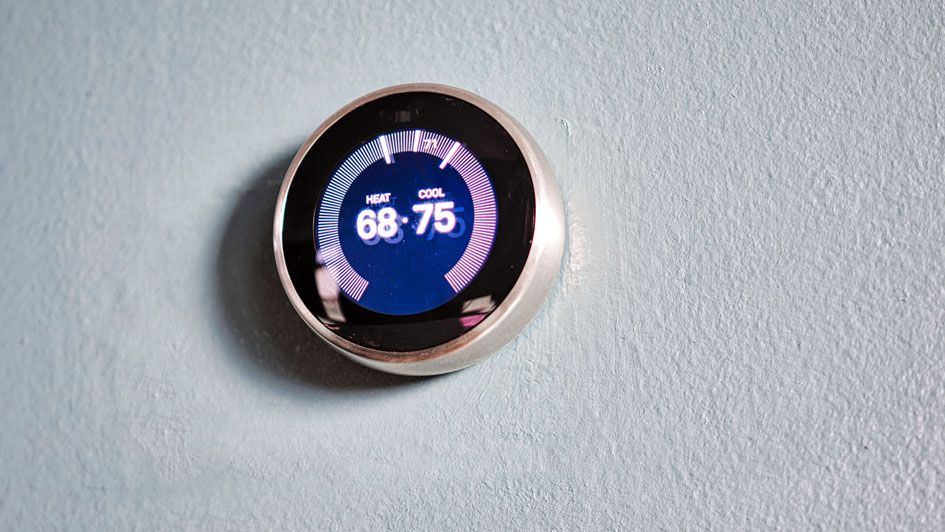
A Nest Thermostat is a great investment for keeping your home comfortable, no matter what the season or weather. With a number of innovative features meant to maximize efficiency, convenience and comfort, a Nest Thermostat is an easy way to manage your energy use — saving you money in the process.
That’s why more homeowners are considering adding devices like a Nest into their home. If you're interested in trying a Nest yourself, reach out to an expert for smart thermostat installation in Thedford.
From auto scheduling to energy efficiency monitoring, Nest is designed to make controlling the climate of your home effortless.
Curious to learn more? Here’s a look at 12 things you need to know about your Nest Thermostat.
1. Resetting Your Nest Thermostat
A key piece of information to know about resetting a Google Nest Thermostat is that there's a difference between a restart and a reset.
- Restart: A common feature in consumer electronics, including your phone or computer, restarting your Nest Thermostat turns it off before starting it right back up again. This preserves current settings and should be attempted if your Nest is frozen or not connecting to Wi-Fi.
- Reset: Conversely, resetting eliminates most if not all of your preferred settings. In most cases, people resort to a reset when they’re moving to a new home and bringing the thermostat with them, or if they're moving out and prefer to erase all personal info from the Nest before leaving it for the next homeowner.
To reset, first write down your temperature settings so reapplying them is faster. Next, locate Settings -> Equipment and write down the details about your system wires, heating type and safety temperature settings.
Once you have recorded your preferences, go to Settings, select Reset and press. You will be presented with five options:
- Restart: Turns your Nest off before rebooting it with your settings. Another way to restart is to press the outside of the Nest and hold it down for a few seconds until it turns black, and then pull your hand away.
- Schedule: This reset setting clears all scheduling information—including for your hot water, if you've connected it to your Nest. By choosing this kind of reset, you’ll need to create a new schedule or wait until the Nest learns your schedule.
- Away: This kind of reset removes anything your Nest has learned about how often you walk by, so it will be able to change the temperature even when you're not around.
- Network: With a network reset, it erases connection info and your Nest will no longer be connected to Wi-Fi. Use this option if you want your Nest to forget your Wi-Fi password.
- All Settings: The most far-reaching option, using the All Settings reset option clears all your personal settings and learning.
2. How to Connect Nest Thermostat to Wi-Fi
Staying connected to your Wi-Fi is important to getting the most out of your Nest.
To connect your Nest to the internet:
- Open the Quick View menu by turning the thermostat ring.
- Select the Settings icon.
- Choose Network.
- As your Nest is finished scanning for local networks, locate your Wi-Fi and, if necessary, enter your password.
3. Does a Nest Thermostat Have a Battery and How Long Does It Last?
Nest thermostats are powered indirectly through HVAC system, but each one also features a rechargeable lithium-ion battery for backup in situations where the power cuts out. According to Google, who manufactures the thermostat, a Nest Thermostat battery last an average of several months. Recharge it with the USB cord that comes included.
4. How to Turn Off a Nest Thermostat
If you plan on being away for a couple weeks, it's a good idea to set your Nest Thermostat to Off mode, though Eco mode would be another option. The Off mode option deactivates your regular heating and cooling schedules, but it will still adhere to any current Safety Temperatures to keep your home from getting particularly hot or cold.
To find Off mode on the thermostat:
- Press and hold the touch bar until it displays “Turn Off” and then slide the bar to highlight Turn Off, and then touch the bar to select.
- Or, from the main menu, go to Mode and select Off.
Off mode is available on the Google Home app as well:
- Select Thermostat from home screen
- Tap Temperature mode
- Select Off
5. Is Alexa Compatible with a Nest Thermostat?
Yes, you can use Amazon Alexa to control a Nest Thermostat. This voice control function is also available with Nest doorbells and cameras. And of course, you can use Google Assistant to control your Nest.
6. Can a Nest Thermostat Function Without Wi-Fi?
The good news is that a Nest Thermostat can still control temperatures even without Wi-Fi. That being said, a lack of an internet connection means your Nest doesn’t have access to all the key features that most people enjoy.
7. Are You Able to Lock a Nest Thermostat?
When family members can't stop bickering over temperatures, Nest can help you bring a little order back to your household.
A user can 'lock' the Nest to stop any temperature adjustments outside of a preset range. This won't mean you have to make do with just one temperature—a locked Nest continues to use existing program settings—but simply keeps these settings from being changed.
To lock a Nest:
- Tap the Settings icon, scroll to the bottom and tap on Lock.
- Enter a 4-digit pin number you can remember, and then enter it twice.
- To lock your Nest in Heat or Cool mode, define your maximum and minimum temperature range before tapping Lock at the bottom of the screen.
To unlock a Nest, open the settings and choose Unlock. As soon as you've provided your 4-digit pin, your device will be unlocked.
8. Controlling Your Nest Thermostat from a Phone
Nest thermostats can be controlled by your Google Home app, accessible through your phone or desktop computer. Other versions of Nest, including the Nest Thermostat E and Nest Learning Thermostat, are also compatible with remote control via the Nest app.
Before you can control a Nest on your phone with Google Home or the Nest app, there are a few steps to complete first:
- Download the Google Home app or, with premium Nest models, the Nest app to your phone.
- Connect your Nest Thermostat.
- Access the Google Home app on your phone and complete the setup process, link to your new device and connect to Wi-Fi.
- There is a guided setup tool on Google, for those needing extra assistance in connecting.
After you've added the Nest to your Home app, you can access it by clicking Thermostat on the home screen. Once you do that, you can make changes to the temperature by dragging your finger along the screen or tapping on a plus or minus sign.
The app also allows you to change the Nest's preset temperatures. From the home screen, choose Thermostat before selecting Settings. At this screen, select Temperature Preferences and then Temperature Presets. The display will show your preferred Comfort, Eco and Sleep temperatures. By selecting one of those three options, you can change the temperature for that preset.
9. Creating a Nest Thermostat Schedule
A Nest allows you to set temperatures schedules either on the device or on the Google Home app. Newer and advanced models of the Nest, such as the Nest Thermostat E and Nest Learning Thermostat, are also controllable with the Nest app.
There are two ways you can set up a schedule on your Nest:
- Quick Schedule: A Quick Schedule will be based on the national average schedule for more energy-efficient use. As you complete your Nest's setup process, the Google Home app gives you the option to change the temperature with a schedule. If you choose that option, it presents a preset schedule for you to customize as you wish. Once setup is complete, that’s the schedule it uses.
- Temperature Presets: To change the temperature presets on your Nest, open the Google Home app and select Thermostat. Then, tap Presets and choose Edit. Once you’ve made the changes, select Done.
To make tweaks or changes to your current schedule, open the Google Home app, select Thermostat and then tap on Schedules. Find the time of week you want to add a temperature to. Once you pick the day, tap Add and select the preset you want. Finally, select Time before touching and dragging the numbers to change the time. Select Done to save changes.
10. Setting a Temperature Range on a Nest Thermostat
You can set a temperature range on a Nest Thermostat in the Eco mode. Your Nest will adjust the temperature depending on if you're at home or away.
To create a custom temperature range in Eco mode, go to Settings and select Eco. The thermostat's display should list existing “Heat to” and “Cool to” temperature settings. You can select each and make any and all adjustments. When complete, select Done.
11. What to Do if a Nest Thermostat Is Not Compatible
Nest thermostats can be integrated with most HVAC systems. The maker of Nest, Google, features a compatibility checking tool that asks a series of questions about your location and existing setup to learn which Nest model would be compatible with your system.
If you don't think your Nest is compatible with your system, it’s best to reach out to a professional for smart thermostat installation in Thedford. Experienced technicians evaluate your system and, if your Nest is compatible, get it installed and on the road to saving you money in no time.
12. How Do I Manually Control My Nest Thermostat?
Nest Thermostats come with many features designed to increase comfort and decrease costs. However, you can actually turn off the smart features if you prefer manual controls similar to normal thermostats.
Bear in mind, by doing this you are turning off all of your temperature schedules and letting the Nest work like any other thermostat—it will display the temperature and allow changes, but that’s about it.
Setting your thermostat to manual controls can be accomplished with the following steps:
- Auto-Schedule: From the main screen, go to Settings and then scroll to Nest Sense. Go to Auto-Schedule, select No and click Done.
- Eco: From the main screen, go to Settings, scroll to Eco. Once in Eco, select Off for both the Heat to and Cool to temperatures, before selecting Done.
- Home/Away Assist: From the main screen, go to Settings and select Home/Away Assist. Then, select Stop Using and click Done.
- Reset: Once you’ve turned off the settings, reset your nest. From the main screen, go to Settings and select Reset, highlight Schedule and then select Reset to clear out any saved scheduling data.
